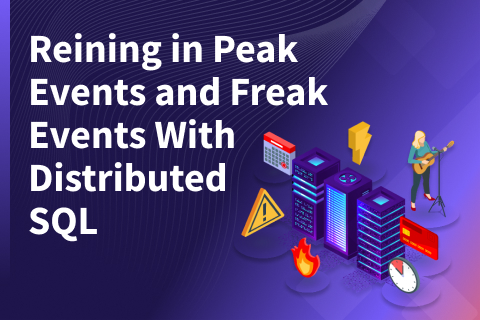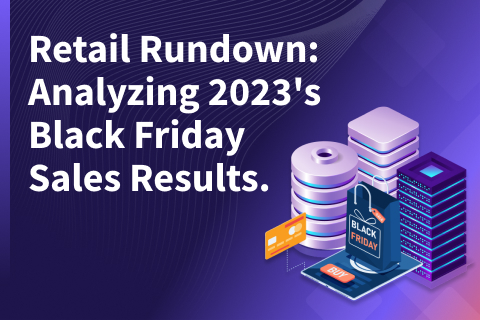Spot the 6 Red Flags That Your Ecommerce Website Might Crash
Retailers operate in a highly competitive space. Success hinges on customer happiness, and customer happiness hinges (in many cases) on instant gratification and smooth processes.
Quick, consistent, always-available performance is non-negotiable. Customers expect to shop 24/7. Any slowdown or downtime not only results in immediate revenue loss but can cause long-term brand damage and, for public companies, a hit to the stock price.
There’s a lot at stake. With over 26 million active eCommerce sites globally, over half of which are in the United States*, the market is as big as the opportunity. By the end of 2023, global eCommerce sales are expected to reach $5.8 trillion, with an average increase of 8.2% projected every year till 2027.
*Followed distantly by the UK, Brazil, Germany, and Australia.
While eCommerce operations have lower overhead than traditional brick-and-mortar retail, their website is the lynchpin to success.
A continuously available, responsive site will capture a larger share of that 5.8 trillion dollar market. A site that struggles with traffic surges, becoming slow or unresponsive at critical moments, risks forfeiting an equally substantial part of that market share.
But when do these traffic surges hit? When is the risk the highest?
There are six key points in time that have the potential to cause demand/traffic to spiral up and send your website (as well as your reputation, revenues, and stock price) crashing to the ground.
- New product launches
- Exclusive events
- Natural disasters
- Influencer/celebrity endorsements
- Black Friday/Cyber Monday
- Unpredictable events
Let’s examine these scenarios and review real-life examples to help you avoid similar situations.
New Product Rollouts (and Consumer Excitement)
A product launch not only provides a new product for people to purchase, but it also builds excitement around the brand, provides free publicity, and gains the retailer/manufacturer industry recognition. The goal of a product launch is to drive traffic to your brand—either online, in-store, or both.
That said, the release of a new gaming console is a big deal…a very big deal. Because new rollouts represent the next generation in gaming, the urgency to buy (and be first to play) is intense. Retailers also have the opportunity to make additional profits from add-ons like games and accessories. Think of it like Black Friday and Cyber Monday rolled up into one.
But what if something goes wrong….?
In the case of the PlayStation 5, something did go wrong. Several retailers jumped the gun and released pre-orders earlier than scheduled, despite Sony’s assurances to customers that there would be no surprise announcements regarding pre-orders.
The result? Chaos. Broken links, failed orders, and several eCommerce sites, including GameStop’s, crashed due to the high traffic. And Sony is not the only one to have gotten it wrong and paid the price. In 2021 alone, the Google store crashed due to pre-orders of the Pixel 6 mobile phone. The Gap’s site crashed thanks to the drop of the Yeezy GAP jackets, and even the Chinese Apple store crashed from iPhone preorders.
High-Demand Events ….and Bots
So, now let’s address the Taylor Swift/Ticketmaster debacle.
In November 2022, ticket presales opened for Taylor Swift’s “Eras” tour. To say that there was massive demand would be an understatement. More than 2 million tickets were sold in a single day.
The unprecedented demand overwhelmed Ticketmaster’s platform, resulting in extremely long wait times, tickets disappearing from shopping carts, payment problems, and widespread frustration/anger from fans and Swift herself.
Ticketmaster initially tried to downplay the issues, stating that only 15% of website interactions “experienced issues.” If true, that is still a large amount of goodwill lost given the volumes involved.
And it wasn’t just fans who overwhelmed the site. There was also a record number of bot attacks—three times more than the previous high.
Despite having a “Verified Fan” program to ensure ticket buyers were genuine fans, the influx of bots trying to gain access to verification codes further strained the platform, deteriorating the fan experience even more.
The fallout from this chaotic presale event has been significant. Not only has Ticketmaster been the subject of widespread negative media coverage and Congressional hearings, but it now faces lawsuits from hundreds of disgruntled fans.
Natural Disasters
An electrical storm in Virginia, Hurricane Sandy hitting the East Coast, and an ice storm in Texas have one thing in common besides being natural disasters. In addition to knocking down power lines and disrupting people’s lives (to varying degrees), they took out multiple data centers affecting high-profile sites including Instagram, Netflix, Buzzfeed, and Huffington Post.
But it is not just social media and news sites that are impacted by natural disaster-related downtime. In February 2021, Texas saw an unusual cold snap morph into a devastating ice storm that took out critical utilities across the state, plunging homes, businesses, and data centers into darkness. The initial storm hit on February 13, 2021, but the impact and damage lingered. Widespread power outages and water service shutdowns spelled disaster for many, but a Big Three retailer (who must, unfortunately, remain anonymous) sailed through the week with no problems thanks to their decision to deploy their distributed SQL database cluster across three regions with synchronous replication across the regions. When one region went down, the other two picked the slack quickly and seamlessly.
How a Fortune 500 Retailer Weathered a Regional Cloud Outage with YugabyteDB
Influencer/Celebrity Impact
During her engagement announcement to Prince Harry, Meghan Markle wore a ‘Line the Label’ white belted coat. Although the coat wasn’t sold online, fashion enthusiasts keen to emulate her look flooded the company’s website, which then crashed. Her sister-in-law, the Princess of Wales, has also crashed multiple websites over the last decade, including Jenny Packham, Shola, and Anita Dongre.
The unpredictability of these endorsements often catches companies unprepared. No one knows when a celebrity/royal/influencer will step into the spotlight and shine a spotlight on a product. To complicate things more, no one knows when that spotlight will morph into a viral moment that causes a run on the website. Databases must be ready to quickly scale to accommodate any sudden influx of traffic honing in on your brand.
Black Friday/Cyber Monday
Approximately 60% of the US population shops on Black Friday making it one of the most important days of the year for retailers. Cyber Monday/Cyber Week attracts even more people, with 76% of all US consumers participating.
However, each year, several companies show that they are ill-prepared for the substantial traffic surge. The result is long days and nights for IT and database professionals working to quickly fix problems while continuing to manage the increased demand and traffic.
Here are just a few examples of the issues major retailers have faced during these key shopping events:
- Lululemon. On Thanksgiving Day 2018, Lululemon’s website crashed during its weekly overstock sale. As a Canadian company, Lululemon had not participated in any traditional Black Friday event. However, Thanksgiving in the United States happens to fall on their weekly “We Made Too Much” sale, held every Thursday to offload excess items. Unprepared for the influx of shoppers from another country looking for holiday bargains, the site would not let people complete orders, leading to widespread frustration and hours-long waits. Social media also knows no geographical boundaries, and Lululemon’s shortcomings were soon broadcast across the globe.
Cross-border sales to US consumers were up 42% YoY in May 2020, and 23.55% of online sales in Europe are cross-border sales.— Retail Today and eCommerce News Europe
- J.Crew. J.Crew’s website encountered issues on Black Friday after being overwhelmed by an unexpected surge in traffic. The crash impacted approximately 323,000 shoppers and cost the company between $700,000 and $775,000 in sales. The snafu occurred periodically across five hours, showing shoppers a “Hang on a Sec” screen and preventing them from signing in and completing orders.
- Lowe’s. Lowe’s experienced similar technical problems on Black Friday, greeting online shoppers with a message that its website was “down for maintenance.” Customers complained (a lot) about the lack of access, and the company had to fully shut down the site and relaunch later in the day. To prevent a recurrence of this issue, they then revamped their entire (decades-old) system.
- Costco. When Costco’s website went down for over 16 hours, the company reportedly lost over $11 million. The crash was attributed to an influx of shoppers eager to grab the deals the club store was offering on laptops, TVs, and other electronics. Customer frustration was widely shared across different social media platforms (who handled that influx of traffic just fine). In response, Costco was forced to extend its one-day Thanksgiving Day sale to the next day (Black Friday).
- Microcenter. Microcenter experienced a series of issues over the course of 45 minutes during a Black Friday event. Due to high amounts of traffic, their website took more than 10 seconds to load, or it did not load at all. As you might have expected, people immediately complained on social media.
Other sites that struggled (and crashed) due to an inability to handle significant traffic spikes include Office Depot, Ulta, Macy’s, Saks Fifth Avenue, Brooks Running, and UK-based brands JD Sports, John Lewis, Game, and Debenhams.
Black Friday/Cyber Monday crashes are not a problem relegated to the last decade. The issue persists. In fact, in 2021, almost 2 out of every 3 consumers experienced technical issues on Black Friday. The issue is now so commonplace that it simply does not provoke the level of media attention it once did.
Unexpected events that no one saw coming
No one expects their building to catch fire, a transformer to blow, or equipment to malfunction. But they do.
Everything in the physical world has the potential to break, leading to a cascade of problems. For instance, on March 10, 2021, a fire swept through OVHcloud’s data center in Strasbourg France. The rapid destruction of multiple buildings caught many off guard. OVHcloud’s immediate response was to tweet a recommendation that their customers activate their disaster recovery plans.
Unfortunately, many of those customers discovered that their DR plans did not take into account the possibility that a fire could affect multiple buildings at the same facility. Those who relied on data backups located on different servers in the same facility found themselves without any backups.
For another example, let’s revisit Lululemon. In May 2017, the company’s website went down for about 24 hours over several days. It was reported that a power failure and “other problems” in a data center caused the issue. The exact nature of what happened (other than the initial power failure) remains unclear, but what is clear is that random and unexpected events do happen. You may not see them coming, but if you are not prepared for their possibility, the consequences can be severe.
Impact of website crashes
So, what are the consequences of a retail website crash? In the world of eCommerce, there are few things worse than realizing your pages will not load and that your sales are $0. This is especially true if your site fails during a traffic peak (refer back to the examples above!). You have now either put a large chunk of your yearly revenue at risk or missed your viral moment and any/all opportunities to grow.
According to Gartner, downtime costs an average of $5,600 per minute. And that is just the average! Depending on your industry, size, and the time/day of failure, the per-minute rate can be as high as $83,000. Just 5 to 15 minutes of downtime during a peak traffic period could be financially devastating.
But it is not just financial results in real time. If a large percentage of sales come from your website, any type of performance issue or crash can impact same-day comps. Investors and analysts scrutinize these comps to predict the future success of retailers. So the impact can have a longer tail than may be obvious at first. For example, the power loss that caused Lululemon to go offline for approximately 24 hours over three days cost the company a penny in earnings per share.
So the question is, what can you do to avoid being another eCommerce cautionary tale?
Meet the Resilient, Highly-Available, Imminently Scalable Database for eCommerce Success
The YugabyteDB database is designed to provide low latency along with a high level of resiliency, scalability, and availability. It ensures retail applications and websites remain up and highly performant, keeping your customers happy. Even better, it can be deployed everywhere—across hybrid clouds, public clouds, VMs, or containers-with no vendor lock-in.
Native Resilience and Flexible Disaster Recovery
YugabyteDB ensures there are no disruptions to your retail business, even during unplanned failures, moments of eye-boggling traffic, and/or planned maintenance. Meet and even exceed your SLAs, as your data stays available across zones, regions, and data centers.
Horizontally Scale For Peak Traffic Periods
Begin small and effortlessly scale data, connections, reads, writes, and transactions. Whether traffic peaks are expected or not YugabyteDB excels under pressure, seamlessly scaling out or up without sacrificing performance. Then, it easily scales back down to help you manage costs.
Global-Ready Application Blueprints
Ecommerce knows no geographic boundaries, as Lululemon learned to their peril. With YugabyteDB, you can distribute data to ensure speedy transactions, architect for resiliency, or keep everything local for compliance. Utilize asynchronous or synchronous replication to optimize deployments and offer fast, seamless shopping experiences globally.
Want to learn more about YugabyteDB’s extremely low latency, massive scale, and comprehensive set of multi-region deployment options? Here are some more resources to explore:



